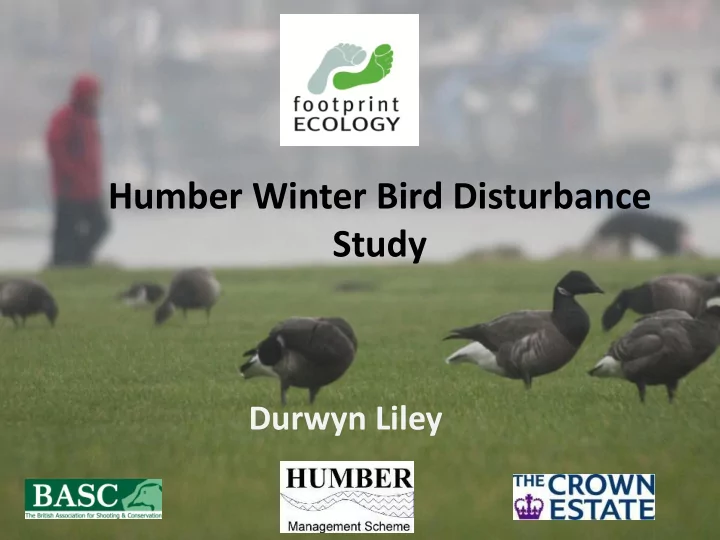

Humber Winter Bird Disturbance Study Durwyn Liley
Disturbance • Difficult to define • Difficult to understand scale of impact • Avoidance, direct mortality, behavioural response and physiological impacts • Difficult to manage
Methods • October & January • 4 visits in each month; to 10 locations • Each visit around 1hr 45 minutes (70 hrs per month) • Focal area of 500m around survey point allows systematic recording • ‘Diary’; Bird Count; Response of Birds; • Visits not at random, but to some extent targeted (tide/weather) – e.g. Welwick 2 visits close to dusk
Recording Responses • Diary involved all activities/events during 1 hr 45 minutes. Outside and around 500m focal area. • If event occurred within 200m of birds in the focal area – or birds responded (any change in behaviour), then event was a potential disturbance event and triggered entry on response form. • Systematic recording including no response
Results: Recreation • 1,304 events in the diary • 2,280 people and 839 dogs • Dog walking most common activity: 45% of records. 3x as many dogs off lead as on. Most commonly recorded activity on intertidal habitats and shoreline. • In general most activities on shore, but at Humberston, Horseshoe Pnt & Cleethorpes relatively high proportion activities on intertidal • Water-based activities only accounted for 1.5% of observations and were restricted to 2 sites, Chowder Ness and Faxfleet.
Birdwatching more common during weekend; cycling, jogging, wildfowling during the week. Oct busier than Jan.
Activities by location
Activity by site
Bird Data • 29 bird species (waders, wildfowl, herons, divers & grebes etc. recorded). • No. of species recorded per location varied from 9 to 28 • Wader numbers higher in Jan at 7/10 sites; wildfowl nos. higher in Jan at 6/10 sites
Average counts in Jan & Oct
Bird numbers in relation to access • Little evidence that density of birds at sites was related to level of access overall at each site • Using count data from each visit in GLM we tested whether bird numbers at end of count were related to the number of visitors. Significant negative effects for waders and wildfowl. Tide state and location also significant for waders and location for wildfowl.
Behavioural Response Number (%) of species-specific disturbance events Response Total October January No response 1851 (69.2) 1232 (74.4) 619 (60.7) Alert 70 (2.6) 34 (2.1) 36 (3.5) Walk/Swim 205 (7.7) 109 (6.6) 96 (9.4) Minor flight 179 (6.7) 53 (3.2) 126 (12.4) Major flight 370 (13.8) 228 (13.8) 142 (13.9) Total 2633 (100) 1626 (100) 1007 (100) no response alert all walk/swim responses minor flight major flight 0% 10% 20% 30% 40% 50% 60% 70% 80% 90% 100%
Responses by Activity
Response by species
Factors influencing response Variable Details Survey location Highest probability of flights at S’fleet &Welwick Month October<January Temperature Few flight responses at temperatures <0°C. -ve relationship >0°C Tide Low tide<Other tidal phases Distance to disturbance -ve relationship with distance No. of people in group Non-linear response Activity type (water-based, Other>Water-based>Foot/bike foot/bike, other) Dog(s) present Significant effect when only Foot/bike activities were considered No. of dogs off lead Significant effect when only Foot/bike activities were considered No. of dogs on lead No significant effect Weekend vs weekday Weekend>weekday Species Higher flush rates for mallard, teal, wigeon and lapwing Sp. group No significant effect Flock size Positive relationship with flock size Behaviour No significant effect
Displacement
Limitations • Variations between sites: Cleethorpes exceptionally busy and difficult to count people accurately • Some activities missed/underestimated (wildfowlers?) • Level of survey effort: 14 hours per point; only 10 points. Only 2 months.
Implications for Management • Dog walkers, with dogs off leads: 45% of all major flights observed (and 35% of access) • Walking: 12% of all major flights (29% access) • Birdwatching: 9% of all major flights (5% access) • Air-borne craft 6% of all major flights (1% of access) Watersports: no kitesurfing, windsurfing or canoeing recorded. Careful monitoring recommended
Where open soft mud… • Low probability of flushing at low tide. • Where plenty of open soft mud away from shore, little concern relating to disturbance and feeding birds/low tide
Quiet areas important • Some evidence that in areas with low levels of access, higher probability of individual disturbance events flushing birds. • At quiet sites birds potentially not distributing to avoid access or access more unpredictable. • Merit in maintaining quiet areas with low levels of access. Not promoting/providing parking etc.
Dog walking • Dogs on leads or reducing number of dog walkers per key Options include awareness raising, dedicated dog-off lead areas, clear signposting, dog control orders.
Paull
Paull • Particularly high flush rates and disturbance to roosting birds. • Redirecting paths, screening, low fencing etc. may be beneficial
Open sandy areas • Cleethorpes, Humberston Fitties and number of other sites access spreads out onto intertidal • Difficult to manage. • Limiting entry points, reducing parking locations, provision of way-marked routes.
Monitoring • Access patterns change • Paddleboarding, night cycling, canoeing, range of watersports.
Recommend
More recommend